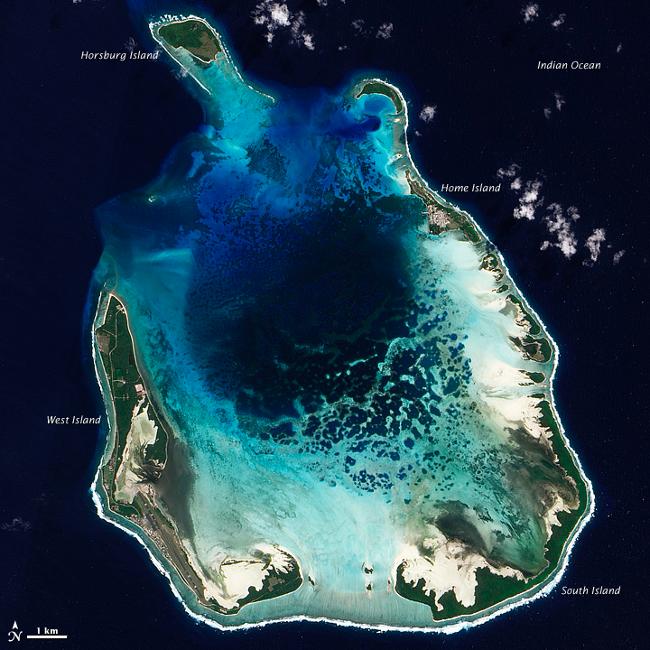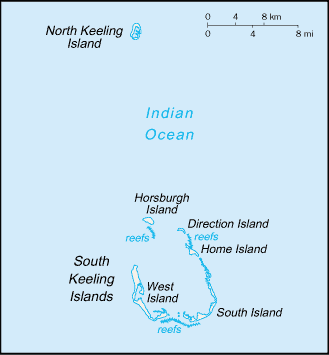Introduction :: COCOS (KEELING) ISLANDS
-
There are 27 coral islands in the group. Captain William KEELING discovered the islands in 1609, but they remained uninhabited until the 19th century. From the 1820s to 1978, members of the CLUNIE-ROSS family controlled the islands and the copra produced from local coconuts. Annexed by the UK in 1857, the Cocos Islands were transferred to the Australian Government in 1955. Apart from North Keeling Island, which lies 30 kilometers north of the main group, the islands form a horseshoe-shaped atoll surrounding a lagoon. North Keeling Island was declared a national park in 1995 and is administered by Parks Australia. The population on the two inhabited islands generally is split between the ethnic Europeans on West Island and the ethnic Malays on Home Island.
Geography :: COCOS (KEELING) ISLANDS
-
Southeastern Asia, group of islands in the Indian Ocean, southwest of Indonesia, about halfway between Australia and Sri Lanka
12 30 S, 96 50 E
Southeast Asia
total: 14 sq km
land: 14 sq km
water: 0 sq km
note: includes the two main islands of West Island and Home Island
country comparison to the world: 241
about 24 times the size of The Mall in Washington, DC
0 km
26 km
territorial sea: 12 nm
exclusive fishing zone: 200 nm
tropical with high humidity, moderated by the southeast trade winds for about nine months of the year
flat, low-lying coral atolls
mean elevation: NA
elevation extremes: lowest point: Indian Ocean 0 m
highest point: unnamed location 5 m
fish
agricultural land: 0%
arable land 0%; permanent crops 0%; permanent pasture 0%
forest: 0%
other: 100% (2011 est.)
NA
cyclone season is October to April
freshwater resources are limited to rainwater accumulations in natural underground reservoirs
islands are thickly covered with coconut palms and other vegetation; site of a World War I naval battle in November 1914 between the Australian light cruiser HMAS Sydney and the German raider SMS Emden; after being heavily damaged in the engagement, the Emden was beached by her captain on North Keeling Island
People and Society :: COCOS (KEELING) ISLANDS
-
596 (July 2014 est.)
country comparison to the world: 237
noun: Cocos Islander(s)
adjective: Cocos Islander
Europeans, Cocos Malays
Malay (Cocos dialect), English
Sunni Muslim 80%, other 20% (2002 est.)
0% (2014 est.)
country comparison to the world: 199
total: NA
male: NA
female: NA
total population: NA
male: NA
female: NA
NA
NA
NA
NA
Government :: COCOS (KEELING) ISLANDS
-
conventional long form: Territory of Cocos (Keeling) Islands
conventional short form: Cocos (Keeling) Islands
etymology: the name refers to the abundant coconut trees on the islands and to English Captain William KEELING, the first European to sight the islands in 1609
non-self governing territory of Australia; administered from Canberra by the Department of Regional Australia, Local Government, Arts and Sport
non-self-governing overseas territory of Australia
name: West Island
geographic coordinates: 12 10 S, 96 50 E
time difference: UTC+6.5 (11.5 hours ahead of Washington, DC, during Standard Time)
none (territory of Australia)
none (territory of Australia)
Australia Day, 26 January (1788)
23 November 1955 (Cocos (Keeling) Islands Act 1955); amended many times, last in 2010 (2016)
common law based on the Australian model
see Australia
18 years of age
chief of state: Queen ELIZABETH II (since 6 February 1952); represented by Governor General of the Commonwealth of Australia General Sir Peter COSGROVE (since 28 March 2014)
head of government: Administrator (nonresident) Barry HAASE (since 6 October 2014)
cabinet: NA
elections/appointments: the monarchy is hereditary; governor general appointed by the monarch on the recommendation of the Australian prime minister; administrator appointed by for a 2-year term and represents the monarch and Australia
description: unicameral Cocos (Keeling) Islands Shire Council (7 seats; members directly elected by simple majority vote to serve 4-year terms with a portion of the membership renewed every 2 years)
elections: held every 2 years with half the members standing for election; last held in October 2015 (next to be held in October 2017)
highest court(s): under the terms of the Territorial Law Reform Act 1992, Western Australia provides court services as needed for the island including the Supreme Court and subordinate courts (District Court, Magistrate Court, Family Court, Children's Court, and Coroners' Court)
none
The Cocos Islands Youth Support Centre
none
none (territory of Australia)
none (territory of Australia)
the flag of Australia is used
note: as a territory of Australia, "Advance Australia Fair" remains official as the national anthem, while "God Save the Queen" serves as the royal anthem (see Australia)
Economy :: COCOS (KEELING) ISLANDS
-
Coconuts, grown throughout the islands, are the sole cash crop. Small local gardens and fishing contribute to the food supply, but additional food and most other necessities must be imported from Australia. There is a small tourist industry.
$NA
1% (2003)
country comparison to the world: 175
vegetables, bananas, pawpaws, coconuts
copra products, tourism
NA
note: the Cocos Islands Cooperative Society Ltd. employs construction workers, stevedores, and lighterage workers; tourism is the other main source of employment
60% (2000 est.)
country comparison to the world: 204
revenues: $NA
expenditures: $NA
1 July - 30 June
$NA
copra
$NA
foodstuffs
Australian dollars (AUD) per US dollar -
1.352 (2016 est.)
1.3291 (2015 est.)
1.3291 (2014)
1.0358 (2013)
0.97 (2012)
Economy :: COCOS (KEELING) ISLANDS
-
Coconuts, grown throughout the islands, are the sole cash crop. Small local gardens and fishing contribute to the food supply, but additional food and most other necessities must be imported from Australia. There is a small tourist industry.
$NA
1% (2003)
country comparison to the world: 175
vegetables, bananas, pawpaws, coconuts
copra products, tourism
NA
note: the Cocos Islands Cooperative Society Ltd. employs construction workers, stevedores, and lighterage workers; tourism is the other main source of employment
60% (2000 est.)
country comparison to the world: 204
revenues: $NA
expenditures: $NA
1 July - 30 June
$NA
copra
$NA
foodstuffs
Australian dollars (AUD) per US dollar -
1.352 (2016 est.)
1.3291 (2015 est.)
1.3291 (2014)
1.0358 (2013)
0.97 (2012)
Communications :: COCOS (KEELING) ISLANDS
-
general assessment: telephone service is part of the Australian network; an operational local mobile-cellular network available; wireless Internet connectivity available
domestic: NA
international: country code - 61; telephone, telex, and facsimile communications with Australia and elsewhere via satellite; satellite earth station - 1 (Intelsat) (2001)
1 local radio station staffed by community volunteers; satellite broadcasts of several Australian radio and TV stations available (2009)
.cc
Transportation :: COCOS (KEELING) ISLANDS
-
1 (2013)
country comparison to the world: 216
total: 1
2,438 to 3,047 m: 1 (2013)
total: 22 km
paved: 10 km
unpaved: 12 km (2007)
country comparison to the world: 222
major seaport(s): Port Refuge
Military and Security :: COCOS (KEELING) ISLANDS
-
defense is the responsibility of Australia; the territory has a five-person police force
Transnational Issues :: COCOS (KEELING) ISLANDS
-
none













